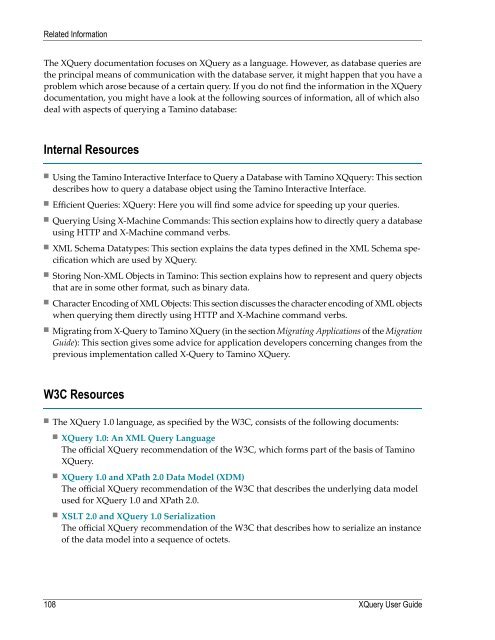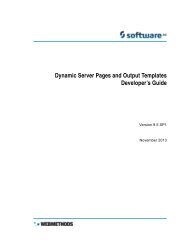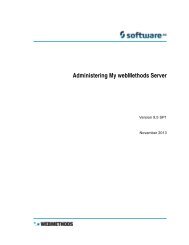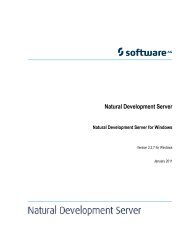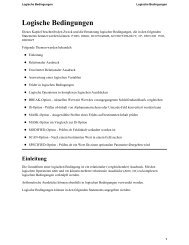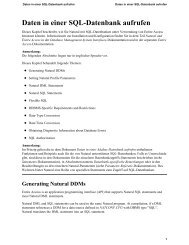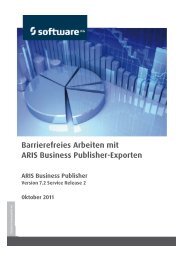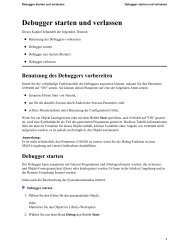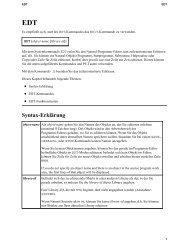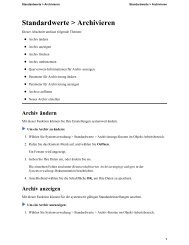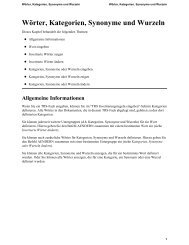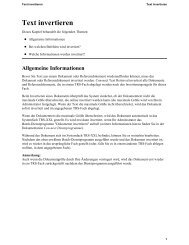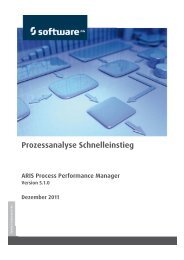Tamino XQuery User Guide - Software AG Documentation
Tamino XQuery User Guide - Software AG Documentation
Tamino XQuery User Guide - Software AG Documentation
You also want an ePaper? Increase the reach of your titles
YUMPU automatically turns print PDFs into web optimized ePapers that Google loves.
Related Information<br />
The <strong>XQuery</strong> documentation focuses on <strong>XQuery</strong> as a language. However, as database queries are<br />
the principal means of communication with the database server, it might happen that you have a<br />
problem which arose because of a certain query. If you do not find the information in the <strong>XQuery</strong><br />
documentation, you might have a look at the following sources of information, all of which also<br />
deal with aspects of querying a <strong>Tamino</strong> database:<br />
Internal Resources<br />
■ Using the <strong>Tamino</strong> Interactive Interface to Query a Database with <strong>Tamino</strong> XQquery: This section<br />
describes how to query a database object using the <strong>Tamino</strong> Interactive Interface.<br />
■ Efficient Queries: <strong>XQuery</strong>: Here you will find some advice for speeding up your queries.<br />
■ Querying Using X-Machine Commands: This section explains how to directly query a database<br />
using HTTP and X-Machine command verbs.<br />
■ XML Schema Datatypes: This section explains the data types defined in the XML Schema specification<br />
which are used by <strong>XQuery</strong>.<br />
■ Storing Non-XML Objects in <strong>Tamino</strong>: This section explains how to represent and query objects<br />
that are in some other format, such as binary data.<br />
■ Character Encoding of XML Objects: This section discusses the character encoding of XML objects<br />
when querying them directly using HTTP and X-Machine command verbs.<br />
■ Migrating from X-Query to <strong>Tamino</strong> <strong>XQuery</strong> (in the section Migrating Applications of the Migration<br />
<strong>Guide</strong>): This section gives some advice for application developers concerning changes from the<br />
previous implementation called X-Query to <strong>Tamino</strong> <strong>XQuery</strong>.<br />
W3C Resources<br />
■ The <strong>XQuery</strong> 1.0 language, as specified by the W3C, consists of the following documents:<br />
■ <strong>XQuery</strong> 1.0: An XML Query Language<br />
The official <strong>XQuery</strong> recommendation of the W3C, which forms part of the basis of <strong>Tamino</strong><br />
<strong>XQuery</strong>.<br />
■ <strong>XQuery</strong> 1.0 and XPath 2.0 Data Model (XDM)<br />
The official <strong>XQuery</strong> recommendation of the W3C that describes the underlying data model<br />
used for <strong>XQuery</strong> 1.0 and XPath 2.0.<br />
■ XSLT 2.0 and <strong>XQuery</strong> 1.0 Serialization<br />
The official <strong>XQuery</strong> recommendation of the W3C that describes how to serialize an instance<br />
of the data model into a sequence of octets.<br />
108<br />
<strong>XQuery</strong> <strong>User</strong> <strong>Guide</strong>


